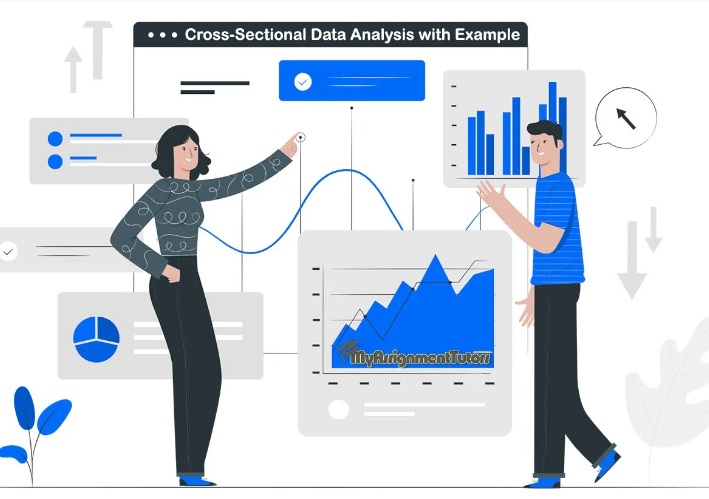Understanding cross sectional data: Definitions, Differences, Merits, and Demerits

What is Cross sectional data
Cross sectional data is a sort of research approach in which information is gathered at one particular moment from a variety of people or institutions. The information is only available at a certain point in time and does not reflect potential future changes. Or to put it another way, it is a snapshot of the population at that certain time.
Research on and health issues frequently uses cross section data to provide a comprehensive picture of a given community. Surveys and questionnaires can be used by researchers to gather data about people’s traits, actions, and views. The data is then examined to look for patterns and trends.
Comparing cross sectional data example to longitudinal data, which gathers data from the same people over time, is common practise. Researchers can track changes in people’s traits or behaviours over time using longitudinal studies. Cross sectional studies are helpful, however, when researchers wish to look at the frequency of a specific trait or behaviour at a specific period.
Example of cross-sectional data
A survey of university students can serve as an illustration of cross section datadata. At one time, the researchers would gather information on a variety of factors, including gender, age, major, academic achievement, and extracurricular activities. The researchers would thus be able to learn more about the traits and behaviours of the student population at that particular time. With the use of this information, they may spot patterns or trends and compare various demographic subgroups. This kind of study, however, would not be able to tell us how these characteristics may have changed through time or how they could alter going forward.
Time series data versus cross section data In the social, economic, and health sciences, time series data and cross sectional data are two often utilised forms of research tools.
Cross sectional data
Data from several sections
Social, economic, and health sciences employ a particular sort of research approach known as cross sectional data. It entails gathering information from several people or organisations at one specific moment. The information is gathered at a single point in time and does not reflect potential future changes. It represents the population at that specific time in a snapshot. Surveys and questionnaires are used by researchers to gather data about people’s traits, actions, and views. The collected data is then examined to look for patterns and trends. To get a comprehensive picture of a given population, cross-sectional data is employed. It is frequently used to determine the frequency of a specific trait or behaviour at one point of time. In contrast to longitudinal data, which is gathered from the same individuals over time and enables researchers to spot changes in people’s behaviour or traits, cross sectional data example are snapshots in time.
Data in time series
A sort of research approach utilised in the social, economic, and health sciences is time-series data. It entails gathering information from the same person or thing over time. Researchers can spot trends, patterns, and cyclical behaviours by using cross sectional data, which is gathered at many time intervals and offers information about how a specific variable has evolved over time.
Time-series data is used to analyse the change in the variable over time, such as population growth, stock prices, or temperature changes, to name a few examples. Researchers use various methods to collect time-series data, such as surveys, questionnaires, or measurements, which they analyse to identify the changes over time.
Time-series data is different from cross sectional data, where data is collected from different individuals or entities at a single point in time. Time-series data provides information on how variables change over time and allows researchers to make predictions about future changes based on the historical trend. This type of data is commonly used in forecasting, decision-making, and policy implementation.
Cross-sectional data applications
cross section dataare frequently utilised in research for a variety of reasons, such as:
Cross-sectional data may be used in descriptive analysis to describe a population or a group at a certain moment. It offers data about the traits, actions, or viewpoints of the populace, aiding in comprehending the existing quo.
Studies on prevalence: cross sectional data exampleis useful in determining the frequency of a specific trait or behaviour in a community. For instance, researchers can estimate the prevalence of obesity or smoking in a particular community using cross-sectional data.
Analysing subgroups:
Researchers can evaluate various subgroups within a population using cross sectional data. For instance, researchers can examine the frequency of a specific trait or behaviour in both men and women.
Finding relationships:
Cross-sectional data is useful in finding relationships between various factors. For instance, researchers can utilise cross sectional data to determine whether there is a relationship between employment and educational attainment.
Management and choice:
Cross-sectional data is utilised to provide information on the traits, actions, and viewpoints of a community in planning and judgement. cross section data, for instance, might assist decision-makers in distributing resources to meet the citizenry’s individual requirements.
Practical examples of cross-sectional data
Some practical examples of cross-sectional data as discussed below:
Health surveys:
To determine the prevalence of a particular health problem or habit, cross section datais frequently utilised in health research. A survey, for instance, may be used by a researcher to gather information on the prevalence of smoking in a population. The researcher would gather information from various people in the population at a specific moment in time and then evaluate the information to determine the population’s smoking prevalence.
Market research:
To understand customer preferences and behaviours, cross sectional data is frequently employed. For instance, a business may undertake a survey to gather information about the traits and habits of its clients. The business might utilise this information to determine client habits and preferences that can be used to design marketing campaigns
Educational research:
Trends in student behaviour or academic achievement can be examined using cross sectional data example. For instance, a researcher may gather information on the academic standing of kids in a specific school district at a particular moment. To find patterns or trends in academic achievement across several grades or disciplines, this data might be evaluated.
Social research:
To comprehend a population’s traits and behaviours, social scientists can employ cross-sectional data. For instance, a researcher may compile information on the average income levels of people in a specific region. This information might be used by the researcher to spot patterns and trends in the income distribution, which could help with the development of income inequality policies.
Overall, cross sectional data is a useful research technique that is applied in many different sectors to learn more about a population at a specific moment. It is a helpful tool for academics and decision-makers who need to comprehend the traits, tendencies, and viewpoints of a group.
The concept behind Rolling Cross-Section A research technique known as the rolling cross-section combines the benefits of cross-sectional and time-series data. In order to track how variables change over time, it entails gathering data from a representative sample of a population at regular intervals, often yearly or biennially. The rolling cross-section approach involves choosing a fresh sample, which is intended to be representative of the population at that specific moment, for each time period. As a result, every sample can be examined as a cross-section, giving a snapshot of the population at that specific time. The samples may also be examined as a time-series to spot patterns and changes over time because they are taken at regular intervals. The rolling cross sectional data approach offers a thorough insight of the population at a specific period while enabling researchers to examine the same factors throughout time. This technique is particularly helpful for tracking how a citizenry’s attitudes, habits, or beliefs develop over time.
Overall, the rolling cross sectional data example is a useful research technique that gives a more thorough insight of how factors change over time and also gives a picture of the population at a specific period.
Merits of cross-sectional studies
Cross sectional datastudies have several merits, including:
Cost-effective:
Analyses using cross-sectional data typically cost less than those using other research methodologies since they only need to gather data once from a sample of the population rather than repeatedly over a lengthy time periods.
Easy and quick to conduct:
Cross-sectional studies are less demanding on the researchers since they can be carried out fairly fast and the data may be collected in a single attempt.
No attrition bias:
Since cross sectional datais collected from all participants at the same time, there is no attrition bias or missing data, which can be a limitation in longitudinal studies.
Wide applicability:
Cross-sectional studies can be used to analyse a wide range of variables and to explore various research questions across a broad range of populations.
Generalizability:
Cross-sectional studies are typically designed to be representative of the population they are studying, which means that the results can often be generalized to the broader population.
Good for hypothesis generation:
It might be helpful to develop hypotheses regarding connections between variables based on cross-sectional research. Further, more focused, and in-depth study may result from this.
In general, cross sectional data studies are a useful research technique that offers a snapshot of a population at a specific period and can offer insightful information on the traits, habits, and viewpoints of a group. Cross-sectional studies may be an economical and productive approach to acquire information and develop research questions.
Demeritsof cross-sectional studies
While cross sectional data examples have many merits, they also have several limitations, including:
Lack of causality:
Cross-sectional studies are not intended to identify causal connections between different variables. Cross-sectional data are gathered at a single point in time, making it challenging to identify the variables that influenced one another.
Limited scope for analysis:
Cross-sectional studies are limited to collecting data at a single point in time, which means that there is a limited scope for analysing changes over time.
Potential for bias:
There is potential for selection bias as cross-sectional studies often involve a non-random sample. This can lead to results that are not generalizable to the broader population.
Difficulty in measuring confounding variables:
Cross-sectional studies often struggle to measure and account for confounding variables that may affect the relationship between the variables being studied.
Self-report bias:
Cross sectional datastudies often rely on self-reported data, which can be subject to social desirability bias or recall bias.
Limited generalizability:
Cross-sectional studies are limited to a particular population at a particular time, which can limit the generalizability of the results.
Cross-sectional studies can be a rapid and affordable approach to collect data, but they have a number of drawbacks. To obtain a more thorough knowledge of the variables being researched, cross-sectional studies should be utilised in combination with other research techniques.
Reach Out to Us
Do not give up if you are having trouble with your assignments on cross-sectional and time-series data. Understanding trends, patterns, and correlations between variables in a variety of domains, including economics, social sciences, and medical, requires the analysis of cross-sectional and time-series data.
As can be seen, cross sectional and time-series data each have specific characteristics, benefits, and drawbacks. Time-series studies are strong at assessing changes over time and may be used to establish cause and effect correlations, whereas cross-sectional studies are cost-effective, quick to execute, and have good generalizability.
You must possess a thorough grasp of the theories, procedures, and techniques in order to properly complete your project on cross sectional data example and time-series data. Significant amounts of investigation, critical thinking, and analytical abilities are needed for this.
Complete Assignment Help is here to assist you if you need assistance with your cross-sectional and time-series data assignments. Our team of specialists has a wealth of expertise working with cross sectional data. They’ll make sure your work is properly researched, well organised, error-free, and submitted on time. Take action now and contact us to obtain excellent assignment assistance.
FAQs
1. What distinguishes cross-sectional data from time-series data?
Time-series data is information gathered from the same population throughout time, whereas cross-sectional data is information gathered from a sample of the population at a particular point in time. Time-series data tells us how the population has changed over time, whereas cross-sectional data gives us a picture of the population at one time.
2. What benefits can cross-sectional data have for research?
Cross-sectional data has the benefits of being inexpensive, quick to collect, and simple to analyse. Also, it aids in the creation of hypotheses on the relationships between different factors, and the findings are frequently generalizable to a larger population.
3. Which restrictions apply to the use of time-series data in research?
The drawbacks of time-series data include the challenge of establishing causality, the possibility of confounding variables, and the challenge of accounting for any outside influences on the data. A lengthy data collection process can also be expensive and time-consuming.
4. Can changes over time be analysed using cross-sectional data?
cross sectional data example, which only offers a glimpse of a population at a certain point in time, is not intended to study changes over time. The analysis of changes through time is better suited to time-series data.
5. What distinguishes panel data from rolling cross-sectional data?
Cross-sectional data that are acquired over time from several population samples is referred to as rolling cross-sectional data. A study design known as panel cross sectional data involves tracking the same group of people across time.
Total Assignment Help
Incase, you are looking for an opportunity to work from home and earn big money. TotalAssignmenthelp Affiliate program is the best choice for you.
Do visit :https://www.totalassignment.com/affiliate-program for more details
Total Assignment help is an assignment help Online service available in 9 countries. Our local operations span across Australia, US, UK, South east Asia and the Middle East. With extensive experience in academic writing, Total assignment help has a strong track record delivering quality writing at a nominal price that meet the unique needs of students in our local markets.
We have specialized network of highly trained writers, who can provide best possible assignment help solution for all your needs. Next time you are looking for assignment help, make sure to give us a try.
Looking for Assignment Help from Top Experts ?
Get the best Assignment Help from leading experts from the field of academics with assured onetime, 100% plagiarism free and top Quality delivery.


